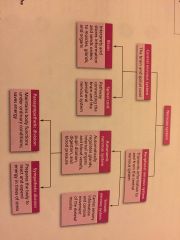![]()
![]()
![]()
Use LEFT and RIGHT arrow keys to navigate between flashcards;
Use UP and DOWN arrow keys to flip the card;
H to show hint;
A reads text to speech;
27 Cards in this Set
- Front
- Back

Front (Term) |
Nervous system |
|
|
Inborn characteristics/emphasized genes |
Nature |
|
|
Nurture |
Focused more on the learning/experience |
|
|
How many chromosomes do sperm and egg contain at conception |
23 chromosomes |
|
|
What do genes consist of? |
Small segments of DNA. Each chromosome contains thousands of genes |
|
|
Human genome |
The complete set of genetic information for humans. Includes the 23 chromosomes pairs |
|
|
Evolution |
The gene change in frequencies over time |
|
|
Survival of the fittest |
The strong who adapt to the environment survive and the weak die out |
|
|
Evolutionary Psychology |
Apply principals of evolution to human behavior and psychological qualities |
|
|
Assumes that the human mind evolved as a collection of specialized modules to handle specific survival problems. Including traits such as infant reflexes |
Evolutionary psychology |
|
|
Sociobiologists believe that gender differences in courtship& mating evolved in response to a species survival needs. |
Evolution and sexual strategies |
|
|
Monozygotic |
(Identical twins) one egg/one sperm = two babies |
|
|
Dizygotic |
(Fraternal twins) two eggs/two sperm = two babies |
|
|
Bulimia |
Involves binge eating and purges |
|
|
Anorexia |
Eating hardly anything |
|
|
|
Structure of the neuron |
|
|
Front (Term) |
The neuron synapse |
|
|
Synaptic bulb |
Rounded areas on the end of the axon terminals |
|
|
Synaptic vesicles |
Saclike structures found inside the synaptic knob containing chemicals |
|
|
Neurotransmitter |
Chemical found in the synaptic vesicles that when released has an effect on the next cell |
|
|
Synaptic gap |
Microscopic fluid-filled space between the synaptic knob of one cell and the dendrites or surface of the next cell |
|
|
Receptor sites |
Proteins on the surface of the dendrites or certain cells of the muscles and glands which are shaped only to fit the neurotransmitters |
|
|
Inhibitory synapse |
neurotransmitter causes receiving cell to stop fighting |
|
|
Antagonists |
Chemical substance that block or reduce a cells response to the action of other neurotransmitters |
|
|
Agonists |
Chemical balances that mimic/enhance the effects of a neurotransmitter on the receptor sites of the next cell increasing/decreasing the cell activity |
|
|
Reuptake |
Process in which neurotransmitters are taken back into the synaptic vesicles |
|
|
Endorphins |
Natural body produced pain killer |

